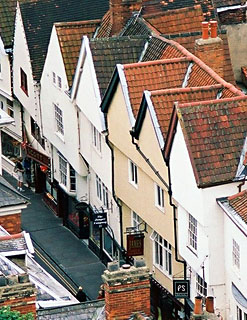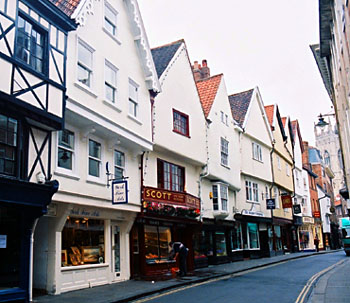
Houses on Low Petergate, York,
as seen from the cathedral tower
Photo © S. Alsford
Towns are like living organisms; they grow, change, decay. We should not be surprised then that most of what medieval townspeople would have recognized as characteristic of their living environments has disappeared from view today, although some remains hidden beneath the ground or behind centuries of refashioning. The visible remnants are dispersed among many locations and rarely in a context which contributes to envisaging a panorama from times long past.
Castles, walls and towers have fallen into ruin, their stones carried off for other uses. Rivers have been tamed, their strands and marshy shores covered with dumped materials and built on, their ports silted up, some of the less hardy along with myriad streams that ran through urban sites have been choked with pollution and sometimes reduced to mere sewers. Ancient bridges have been replaced by structures capable of handling the growing demands of traffic. Marketplaces, castle baileys and cathedral precincts have been whittled down, as parts were put to other use and built on, and their role in society has been partially superseded by shopping centres, sports stadiums, and the like. Parish churches now devoid of parishioners have been converted to other uses or boarded up to become empty shells. Shops and houses have undergone multiple renovations as tastes and lifestyles changed, leading occasionally to suprising architectural discoveries hidden behind layers of newer materials. Civic buildings have been replaced by, or incorporated into, ever more grandiose structures. Fields and pastures that once ringed the town are now obscured by suburban housing estates.
Such are the caprices of time.

Part of the southern stretch of Low Petergate
Photo © S. Alsford